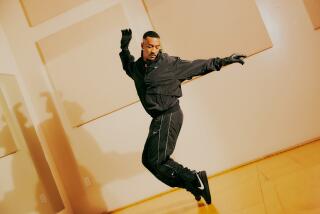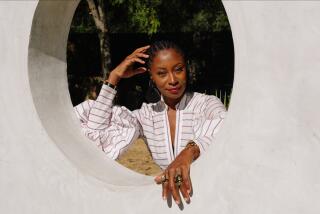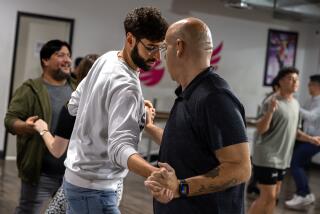Israel’s Batsheva Dance Company visits Royce Hall in celebratory mood
Ohad Naharin does not like to discuss the specifics of the dances he choreographs for the Tel Aviv-based Batsheva Dance Company. Rather, he wants audiences to view them without preconceived expectation.
But the 62-year-old choreographer said that “Sadeh21,” which his company will perform this weekend at Royce Hall, reflects the reasons he’s in a celebratory mood as Batsheva tours the United States on the 50th anniversary of its founding.
“For me, this work is about the love of dance that my dancers and I share and the development of my dancers’ ability to interpret my choreography,” said Naharin, who has created more than 20 dances for Batsheva since becoming its artistic director in 1990.
Naharin has transformed it into one of the world’s preeminent dance companies and attracted dancers from dozens of countries. Over the years, he has created dances that stand out not only for their blend of virtuosity, quirkiness, unpredictability and passion but also for the individualized ways in which his dancers, with their aptitude for both snake-like movement and robotic precision, perform the mostly abstract works.
“Ohad had a tremendous impact on Batsheva by giving it a signature identity and making it special again in the eyes of the world,” said Deborah Friedes Galili, a Tel Aviv-based dance scholar who wrote the book “Contemporary Dance in Israel.”
Naharin largely attributes his innovative abilities to Gaga, the movement language he invented that allows dancers to make individualized discoveries about the kinetic potential of their bodies. Today, the 34-member company uses Gaga as its primary training method and Gaga workshops for both dancers and nondancers can be found worldwide, where participants, through guided imagery, experiment with improvisational movement.
Galili observed that the international popularity of Gaga coupled with Batsheva’s busy overseas touring schedule has also “opened doors” for other Israeli dance companies seeking exposure outside Israel.
“I think Batsheva has helped people, whether they’re audience members or venue programmers, see that there’s quite a world of dance in Israel besides Batsheva. This has benefited both artists who were formerly with Batsheva and artists at the other end of the spectrum,” she said.
Los Angeles audiences, for example, have the opportunity to see performances by two other Israeli dance companies in November. While L-E-V, which will perform at REDCAT, traces its lineage to Batsheva, Kibbutz Contemporary Dance Company, performing at the Wallis Annenberg Center for the Performing Arts, possesses its own distinct history.
Kibbutz Contemporary Dance Company, founded in 1973, mostly performs the works of its artistic director Rami Be’er, whose aesthetic encompasses more classically recognizable ballet and modern dance influences than what might be found in Batsheva’s repertory.
In contrast, Gaga’s anything-goes-as-long-as-it’s-compelling philosophy remains an important ingredient in the choreography of L-E-V’s co-founder Sharon Eyal, who danced for Batsheva from 1990-2008 and served as its house choreographer from 2005-12.
The work Batsheva presents this weekend is one that Naharin created in collaboration with his dancers and aptly encapsulates the legacy of Israel’s flagship contemporary dance company. Consisting of a series of abstract yet highly imagistic vignettes, the dance ultimately celebrates the range of motion and commanding stage presence that audiences have come to associate with the company’s performers.
“The more I choreograph, the more I learn to benefit from my dancers’ moments of genius,” Naharin said, speaking by phone from Israel’s Galilee region. “This is what turns me on every day; that I go into the studio to discover something new with them, and even if I choreograph every single moment, it’s the dancers who keep making discoveries from interpreting those moments.”
Founded in 1964 by the French-born philanthropist Baroness Batsheva de Rothschild, Batsheva benefited from Martha Graham serving as its first artistic advisor and had risen to prominence as a repertory company by the ‘70s.
But during the 1980s, “there was a period where it wasn’t considered at the forefront of contemporary dance. That changed when the company began focusing on Ohad’s works,” said Galili, who credits much of Batsheva’s longevity with Naharin’s ability “to keep things fresh.”
For Sharon Eyal, “Batsheva gave me the freedom to be myself and go wild with my ideas. It was the best place for me to be for a long time,” said the 43-year-old choreographer, speaking by phone from Calgary, Canada, where her company recently performed. “But the only way I could keep my art honest and without compromise was to start my own company.”
With her artistic and life partner Gai Behar, Eyal launched L-E-V last year. The company has performed in Italy, Germany, Mexico, Canada and Massachusetts at the prestigious Jacob’s Pillow festival. At REDCAT, it will perform “House,” a 55-minute dance that has been described by critics as hypnotic, provocative, bold and likely to inspire strong opinions.
“‘House’ is less about a story and more about a dream,” said Eyal, who creates all her dances from her own improvisations, which she then records on video to share with her dancers as they collectively work to refine the movements. “The challenge of my work is for the dancers to really feel what they feel in the moment.”
Eyal echoes the ethos of Gaga, “which also teaches you to pay attention and really listen to people, whether you’re on or off stage,” said Danielle Agami, who danced with Batsheva from 2002 to ’10 and now applies the principles of Gaga as a choreographer with her Los Angeles-based company, Ate9.
Agami will celebrate her own history with Batsheva when she presents her company’s performance installation “Exhibit o” before the Saturday performance of “Sadeh21.” In her opinion, all Batsheva members past and present share a special connection.
“We may dance differently, but we all got this permission from Ohad to move according to our own natural abilities that we then developed. So when I see one of my former colleagues, I feel this connection that’s about a love for movement and being at home with dancing,” she said.
For Naharin, this connection feels deeply mutual. “I used to feel that when people left Batsheva, they were leaving me. Now, it has become a separate thing, and I feel very happy for everyone’s success,” he said.
More to Read
The biggest entertainment stories
Get our big stories about Hollywood, film, television, music, arts, culture and more right in your inbox as soon as they publish.
You may occasionally receive promotional content from the Los Angeles Times.






